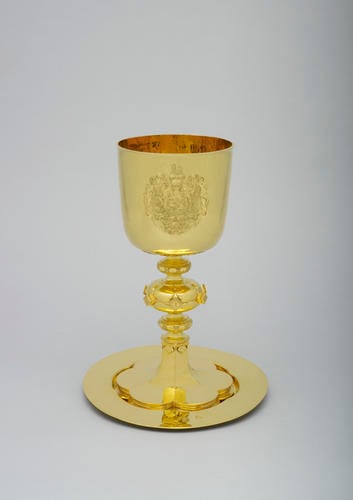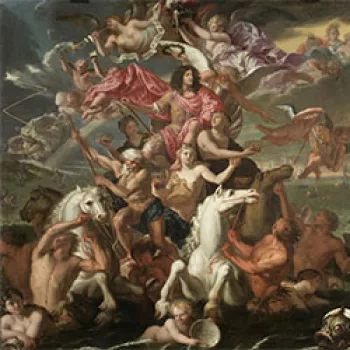Chalice and paten c. 1661
Gold | 1850.0 g (Weight) (parts .a and .b together) | RCIN 31766

-
Gold chalice and paten; the chalice with a moulded hexafoil foot, a triple knopped stem, the central knop chased with converging hexafoil petals, and two oval beads on a matted ground; the bowl engraved with the coat of arms of William III and Mary II, with the sacred monogram IHS. The paten has a hexafoil depression, and is engraved with the Royal coat of arms.
The earliest definite record of the pieces is in the memorandum of 23 February 1684/5, where they appear as the first item, 'One Chalice & Patten poiz 61-12-12. For Gold and Workemanship li.277.06.03'. They appear again in the 1688 inventory and by 1721 were located in the Jewel Office at Whitehall Palace. They were used at the coronations of William and Mary, and Queen Anne and in 1734, were sent to the Chapel Royal, St James's Palace. They were also used during the coronation of George VI.
Unusually, these pieces bear the marks of two makers – the unidentified S.A. and Sir Thomas Vyner. Vyner, goldsmith to the Crown, was not a working smith but a banker and alderman of the City of London, and by the time of Charles II's coronation had in any case largely handed over responsibility for the day-to-day sponsorship of goldsmiths' work to his nephew Robert. Nevertheless he appears to have chosen these two objects on which to establish his name as the supplier of the regalia and altar plate to the king. The chalice and paten were the only items of gold to appear among the altar plate, the gold itself probably originating in Guinea.
The chalice and paten differ from the rest of Charles II's altar plate not only in the material used for their creation. As part of the ceremony of coronation, these works were treated as items of regalia, being carried in the coronation procession alongside the swords and other objects of ceremonial significance. The chalice was the responsibility of Gilbert Sheldon, Bishop of London; the paten fell to John Gauden, Bishop of Exeter. The taking of communion by the king was almost the final act of the coronation service. The office was performed by Matthew Wren, Bishop of Ely, and accompanied by the singing of Intellige Clamorem meum from the choir.
Text adapted from Charles II: Art and Power (2017).Provenance
Supplied for coronation of Charles II, 1661.
Used for Communion during the Coronation service of King Charles III in Westminster Abbey, 6 May 2023, performed by Rt Rev Rose Hudson-Wilkin, Bishop of Dover and Bishop in Canterbury and Rt Rev Dr Guli Francis-Dehqani, Bishop of Chelmsford. -
Creator(s)
(goldsmith)Acquirer(s)
-
Medium and techniques
Gold
Measurements
1850.0 g (Weight) (parts .a and .b together)
Category









